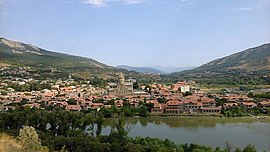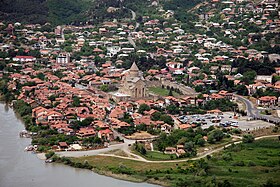Mtskheta
Mtskheta
მცხეთა | |
|---|---|
Town | |
|
UTC+4 (Georgian time) | |
| Postal code | 3300 |
| Climate | Cfa |
| Website | www |
 | |
Mtskheta (
Due to the historical significance of the town and its several outstanding churches and cultural monuments, the "Historical Monuments of Mtskheta" became a UNESCO World Heritage Site in 1994.[3] As the birthplace and one of the most vibrant centers of Christianity in Georgia, Mtskheta was declared as the "Holy City" by the Georgian Orthodox Church in 2014.[4]
In 2016, the Historical Monuments of Mtskheta were placed by UNESCO under Enhanced Protection, a mechanism established by the 1999 Second Protocol to the 1954 Hague Convention for the Protection of Cultural Property in the Event of Armed Conflict.[5]
Geography
Mtskheta is set on a lowland, surrounded by mountains, at the confluence of the two rivers,
History



Foundation
Archeological evidences trace human settlement in the area of Mtskheta from 2nd millennium BC to early 1st millennium AD.[6] Numerous burials of the Bronze Age (beginning of the 1st millennium BC) prove that Mtskheta already was a significant settlement at that period.
According to
Capital of the Kingdom of Iberia
Mtskheta was the capital of the early Georgian
Ancient sources of the 4th-3rd centuries BC mention that Mtskheta had a number of neighbourhoods. Among them, Armazis-tsikhe, Tzitzamuri, Jvari and others. Like other Georgian towns it was divided into the city proper and the citadel.
Both the excavations and
.The city was strongly fortified at that period. Walls lined both sides of the Mtkvari River, and three forts protected it. The main citadel, Armazi, on Mount Bagineti controlled the entrance from the south and east, Tsitsamuri, at the base of Mount Jvari from the north, and Sarkine from the west.
Mtskheta was a site of early Christian activity resulting in the Christianisation of Iberia, where Christianity was proclaimed the state religion in 337. It remains the headquarters of the Georgian Orthodox Church. Around that period Mtskheta was a culturally developed city. A gravestone dated between the late 4th and early 5th centuries, found in Samtavro necropolis, contains an epitaph in Greek, telling about the main architect and archizograph (artist) of Mtskheta Aurelius Acholis.
In the first years after the conversion of Georgia into Christianity, a small wooden church was built in the center of the city, later to become Svetitskhoveli Cathedral. Archeological excavations revealed the remnants of the wooden church within the cathedral. By the 5th century AD the small church was no longer satisfying the growing community of the city, and
Middle Ages
King
Modern times
The old city lies at the confluence of the rivers Mtkvari and Aragvi.
In recognition of its role in the Georgian Christian history, Mtskheta was granted the status of a "Holy City" by Catholicos-Patriarch Ilia II of Georgia in accordance with the written testament of his 11th-century predecessor Melchizedek I of Georgia.[4]
Monuments
UNESCO World Heritage Site | |
|---|---|
| Criteria | Cultural: iii, iv |
| Reference | 708 |
| Inscription | 1994 (18th Session) |
| Endangered | 2009 — 2016[9] |
| Area | 3.85 ha |
| Buffer zone | 2,382.5 ha |


In the outskirts of Mtskheta are the ruins of Armaztsikhe fortress (3rd century BC), the Armaztsikhe acropolis (dating to the late 1st century BC), remains of a "Pompey's bridge" (according to legends built by Roman legionnaires of Pompey the Great in the 1st century BC), the fragmentary remains of a royal palace (1st–3rd century AD), a nearby tomb of the 1st century AD, and the fortress of Bebris tsikhe (14th century). The Institute of Archaeology, and the garden of Mikheil Mamulashvili are also worthy of note.[citation needed] There is also a monument to sculptor Elena Machabeli.

A mausoleum of rich woman from 1st century AD was recovered near Mtskheta train station. The structure imitates a house with well-processed quadrats and a fronton. The roof was covered with tile. Among the findings inside the mausoleum was a small bronze statue of young man playing flute.[6]
Threats
The Historical Monuments of Mtskheta were on UNESCO's List of World Heritage in Danger, citing "serious deterioration of the stonework and frescoes" as the main threat to the site's long-term preservation.[10] They were removed from the list in 2016.[11]
International relations
Mtskheta is
 Vagharshapat, Armenia (2016)[12]
Vagharshapat, Armenia (2016)[12] Leuville-sur-Orge, France (2001)
Leuville-sur-Orge, France (2001) Argos, Greece (1991)[13]
Argos, Greece (1991)[13]
Notable people
Notable people from Mtskheta:
- Tochinoshin Tsuyoshi, (Levan Gorgadze born 1987), sumo wrestler
See also
References
- ^ "Population by regions". National Statistics Office of Georgia. Retrieved 28 April 2024.
- ^ https://agenda.ge/en/news/2014/886
- ^ a b "Historical Monuments of Mtskheta". UNESCO World Heritage Centre. United Nations Educational, Scientific, and Cultural Organization. Retrieved 27 February 2022.
- ^ a b "Historical city Mtskheta becomes "Holy City"". Agenda.ge. 7 April 2014. Retrieved 21 December 2014.
- ^ "Georgia | United Nations Educational, Scientific and Cultural Organization". www.unesco.org. Retrieved 3 May 2019.
- ^ a b Джанберидзе Н., Мачабели К. (1981) Тбилиси. Мцхета. Москва: Искусство, 255 c. (In Russian)
- ^ Александр Джавахишвили. "География Грузинской СССР". Госиздат Грузинской ССР. 1955. P. 162 "Недалеко от Тбилиси расположен древнейший город Грузии — Мцхета (основан приблизительно в V веке до н. э.)"
- ^ a b WORLD HERITAGE LIST: Mtskheta, No. 708 (Report). ICOMOS. 28 October 1993. Retrieved 27 February 2022.
- ^ Centre, UNESCO World Heritage. "Historical Monuments of Mtskheta, Georgia, removed from List of World Heritage in Danger". UNESCO World Heritage Centre. Retrieved 3 May 2019.
- ^ Centre, UNESCO World Heritage. "Georgia's Historical Monuments of Mtskheta inscribed on Danger List". UNESCO World Heritage Centre. Retrieved 3 May 2019.
- ^ "Historical Monuments of Mtskheta, Georgia, removed from List of World Heritage in Danger". Unesco. Retrieved 12 July 2021.
- ^ "Official Website of the Municipality of Ejmiatsin". ejmiatsin.am.
- ^ "Twinnings" (PDF). Central Union of Municipalities & Communities of Greece. Retrieved 25 August 2013.
- Abashidze, Irakli. Ed. Georgian Encyclopedia. Vol. IX. Tbilisi, Georgia: 1985.
- Amiranashvili, Shalva. History of Georgian Art. Khelovneba: Tbilisi, Georgia: 1961.
- Grigol Khantsteli. Chronicles of Georgia.
- Rosen, Roger. Georgia: A Sovereign Country of the Caucasus. Odyssey Publications: Hong Kong, 1999. ISBN 962-217-748-4
External links
- Pictures of Mtskheta
- UNESCO World Heritage listing
 Mtskheta travel guide from Wikivoyage
Mtskheta travel guide from Wikivoyage







